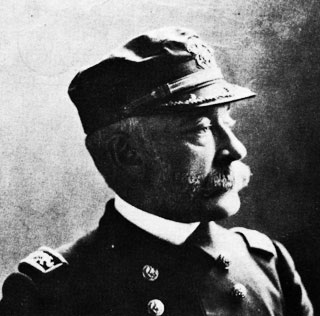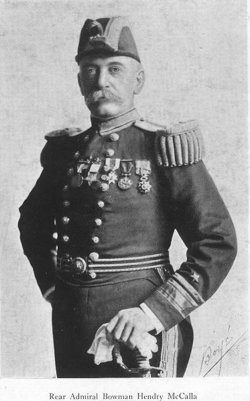|


|
REAR
ADMIRAL BOWMAN HENDRY McCALLA was born in Camden, New Jersey on
June 19, 1844,
and grew up in the city. He was son of Mary Duffield Hendry and
Auley McCalla.
His father was the cashier at the State Bank in Camden (later
the National State
Bank), served on City Council, was one of the original vestrymen
of St. Paul's
Episcopal Church, and was involved with Camden's volunteer fire
fighters as a
founding member, in 1832, of the Perserverence Fire Company. In
1848 Auley
McCalla became secretary and treasurer of the First Presbyterian
Church in
Camden. The 1850 Census shows the family, which then included
older sisters
Elizabeth and Sarah, and a younger sister, Rachel, in Camden's
North Ward. Auley
McCalla passed away in Camden on April 14, 1856. City
Directories from 1863
through 1864 show Elizabeth and Sarah McCalla at 220 North 3rd
Street, and it is
likely that Bowman McCalla lived here prior to going into the
Navy. Elizabeth
McCalla passed in 1877. Sarah stayed in Camden into the 1890s.
Directories in
1887 and 1892 show her living at 116 North 6th Street. She
outlived her younger
brother, dying in Washington DC in 1913.
Bowman H. McCalla was appointed midshipman in the United States
Navy on November 30,
1861. He served his country for over 44 years, rising to the
rank of Rear
Admiral.
McCalla's courage and leadership during
his career often earned him great, and due, respect among his
fellow officers.
He truly was a fighting admiral, on both land and sea. He was
also known as one
of the, if not the most, strictest disciplinarians in the Navy,
and was involved
in a number of controversies during his career.
In the spring of 1885, during the
Panama crisis of
1885, McCalla led an expeditionary force of 750 seamen
and marines which landed at Panama to protect American treaty
rights when the revolution there threatened to block transit
across the isthmus.
In
1888, now ranking as a commander, he was posted to the USS
Enterprise, a barque-rigged screw sloop
built in 1874 at Kittery, Maine. Enterprise sailed from Boston
in January 1888 for two years in the waters of Europe, the
Mediterranean, and the east coast of Africa, where she showed
the flag and looked out for United States' interests. She
returned to New York in March 1890 and was decommissioned on
May 20. Commander McCalla's career was derailed by
an
|
|
incident
that occurred during this cruise. Accused of
overly harsh treatment of his crew, he was court-martialed,
found guilty, and
given a three-year suspension, with pay in May of 1890.
President Benjamin
Harrison returned him to active duty on December 24, 1891. By
October of 1894
Commander McCalla had been posted to the Mare Island Navy Yard
in San Francisco,
California to serve as the naval equipment officer. An
altercation with a
civilian naval contractor brought him to the attention of the
press, but little
came of it.
In
charge of
USS
Marblehead
, September 11, 1897 to September 16, 1898, Commander
McCalla took part in the blockade of Cuba.
During the
Battle
of Cienfuegos he was responsible for the cutting of
submarine cables linking Cienfuegos with the outside world, thus
isolating the Spanish garrison there, in May 1898. In June 1898,
he led the invasion of Guantánamo
Bay and took part in the
Battle
of Guantanamo Bay
and the Battle of Fort Cayo del Tore. Many members of the
Marblehead
crew were awarded the
Congressional
Medal of Honor for their actions during these battles.
On September 14, 1898
Bowman H. McCalla was promoted to the rank of Captain in the
United States
Navy.
In
November of 1898, as Captain of the USS Vulcan, he sailed to Cat
Island in the
Bahamas to determine if the Spanish cruiser Maria Infanta
Teresa, which had hit
a reef and had been abandoned, could be salvaged. The ship was
declared a
hopeless wreck, and Vulcan returned to the navy yard in
Portsmouth, Virginia.
Also
during 1898 Captain McCalla was elected as a veteran companion
of the New York Commandery of the Military Order of Foreign
Wars. He was also a veteran companion of the Illinois Commandery
of the Military Order of the Loyal Legion of the United
States.
In
October of 1899,commanding the cruiser
USS Newark
,
he sailed to the Far East, initially to the Philippines where he
took part
in combined operation with Army General Young, running gunboats
upriver on Luzon
and assisting in island landings elsewhere.
In
March 1900 Captain McCalla was given a full pardon and the
charges from 1890
were purged from his service record. On March 19th Captain
McCalla took the
USS
Newark
to Hong Kong in response to the the Boxer Rebellion
disturbances
in China. Captain McCalla was part of the
China
Relief Expedition during the Boxer Rebellion in 1900. He
was cited for conspicuous gallantry in battle as he led a force
of sailors from Tientsin to Peking. McCalla's force of 112 men
spearheaded an international column,
best known as the
Seymour
Expedition for its leader, British Admiral Sir Edward
Seymour, which was attempting to fight its way to the aid of
foreign legations under siege at Peking. In the course of the
battle at Hsiku Arsenal,
McCalla, along with 25 of his force, was wounded; five were
killed.
Returning
to the United Sta1es aboard
USS Newark
in April of 1901, Captain McCalla was given command of the
battleship
USS
Kearsarge BB-5
before the month of May had ended. In December of 1902 he
was made commandant of the Naval training station in San
Francisco, California.
On July 12, 1903 Captain Bowman Hendry McCalla was placed in
command of the Mare
Island Navy Yard. He was commissioned rear admiral October 11,
1903.
Admiral
McCalla married Elizabeth Hazard Sargent, the daughter of a
Civil War veteran,
Colonel Horace Binney Sargent. The marriage produced four
children, Elizabeth
Hazard McCalla in 1875, Mary Hendry McCalla in 1877, Lily Hazard
McCalla in 1878, and Stella Aphort McCalla in 1878. All three
lived to majority and married.
Mary McCalla married a naval officer Arthur MacArthur. His
brother,
General
Douglas MacArthur, went on to a long career in the
United States Army,
commanding American ground forces in the Pacific during World
War II. Lily
McCalla also married a naval officer,
Dudley Wright
Knox. Commodore Knox is best remembered for his role as
a naval historian.
Rear
Admiral McCall retired from active duty, entering the retired
list on his 62nd
birthday, June 19, 1906. He died on May 6, 1910 in Santa
Barbara, California.
Rear Admiral McCalla was buried at Arlington National Cemetery.
Two ships have
born the name USS McCalla for him, both destroyers.
USS
McCalla DD-253
was laid down in September of 1918, and completed shortly
after the end of World War I. She was given over to the British
Navy in October
of 1940, and as
HMS Stanley
,
was sunk by U-574 on December 19, 1941 near Cape St. Vincent.
USS
McCalla DD-488
was a Gleaves-class destroyer built in 1942.
McCalla
saw a great deal of action in the Pacific during World War II.
She was
transferred to the Turkish Navy in 1949 and was active as
TCG Giresun
until 1973 when she was decommissioned and scrapped. McCalla
Field and McCalla Hill at Guantanamo Bay Naval Base are named
after him as well.
|